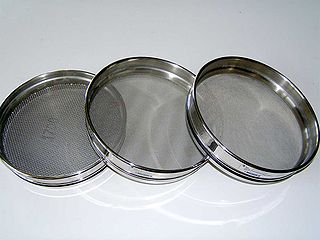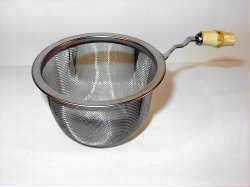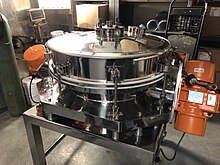
A sieve, fine mesh strainer, or sift, is a tool used for separating wanted elements from unwanted material or for controlling the particle size distribution of a sample, using a screen such as a woven mesh or net or perforated sheet material. The word sift derives from sieve.

A mat is a hard floor covering that generally is placed on a floor or other flat surface. Mats serve a range of purposes including:

A mesh is a barrier made of interlaced strands of metal, fiber or other flexible or ductile materials. A mesh is similar to a web or a net in that it has many interwoven strands.

Mineral processing is the process of separating commercially valuable minerals from their ores in the field of extractive metallurgy. Depending on the processes used in each instance, it is often referred to as ore dressing or ore milling.

Strapping, also known as bundling and banding, is the process of applying a strap to an item to combine, stabilize, hold, reinforce, or fasten it. A strap may also be referred to as strapping. Strapping is most commonly used in the packaging industry.

A window screen is designed to cover the opening of a window. It is usually a mesh made of metal, fibreglass, plastic wire, or other pieces of plastic and stretched in a frame of wood or metal. It serves to keep leaves, debris, bugs, birds, and other animals from entering a building or a screened structure such as a porch, without blocking fresh air-flow.

Mesh is a measurement of particle size often used in determining the particle-size distribution of a granular material. For example, a sample from a truckload of peanuts may be placed atop a mesh with 5 mm openings. When the mesh is shaken, small broken pieces and dust pass through the mesh while whole peanuts are retained on the mesh. A commercial peanut buyer might use a test like this to determine if a batch of peanuts has too many broken pieces. This type of test is common in some industries, and, to facilitate uniform testing methods, several standardized mesh series have been established.

Shale shakers are components of drilling equipment used in many industries, such as coal cleaning, mining, oil and gas drilling.They are the first phase of a solids control system on a drilling rig, and are used to remove large solids (cuttings) from the drilling fluid ("mud").

A coal preparation plant is a facility that washes coal of soil and rock, crushes it into graded sized chunks (sorting), stockpiles grades preparing it for transport to market, and more often than not, also loads coal into rail cars, barges, or ships.

A sieve analysis is a practice or procedure used in civil engineering and chemical engineering to assess the particle size distribution of a granular material by allowing the material to pass through a series of sieves of progressively smaller mesh size and weighing the amount of material that is stopped by each sieve as a fraction of the whole mass.
A vibrator is a mechanical device to generate vibrations. The vibration is often generated by an electric motor with an unbalanced mass on its driveshaft.
Gravity separation is an industrial method of separating two components, either a suspension, or dry granular mixture where separating the components with gravity is sufficiently practical: i.e. the components of the mixture have different specific weight. Every gravitational method uses gravity as the primary force for separation. One type of gravity separator lifts the material by vacuum over an inclined vibrating screen covered deck. This results in the material being suspended in air while the heavier impurities are left behind on the screen and are discharged from the stone outlet. Gravity separation is used in a wide variety of industries, and can be most simply differentiated by the characteristics of the mixture to be separated - principally that of 'wet' i.e. - a suspension versus 'dry' -a mixture of granular product. Often other methods are applied to make the separation faster and more efficient, such as flocculation, coagulation and suction. The most notable advantages of the gravitational methods are their cost effectiveness and in some cases excellent reduction. Gravity separation is an attractive unit operation as it generally has low capital and operating costs, uses few if any chemicals that might cause environmental concerns and the recent development of new equipment enhances the range of separations possible.
Comminution is the reduction of solid materials from one average particle size to a smaller average particle size, by crushing, grinding, cutting, vibrating, or other processes. In geology, it occurs naturally during faulting in the upper part of the Earth's crust. In industry, it is an important unit operation in mineral processing, ceramics, electronics, and other fields, accomplished with many types of mill. In dentistry, it is the result of mastication of food. In general medicine, it is one of the most traumatic forms of bone fracture.
A baghouse, also known as a baghouse filter, bag filter, or fabric filter is an air pollution control device and dust collector that removes particulates or gas released from commercial processes out of the air. Power plants, steel mills, pharmaceutical producers, food manufacturers, chemical producers and other industrial companies often use baghouses to control emission of air pollutants. Baghouses came into widespread use in the late 1970s after the invention of high-temperature fabrics capable of withstanding temperatures over 350 °F (177 °C).
Tumbler screening is a separation method that uses three-dimensional elliptical movement to separate very fine particles from larger ones.
A circle-throw vibrating machine is a screening machine employed in processes involving particle separation. In particle processes screening refers to separation of larger from smaller particles in a given feed, using only the materials' physical properties. Circle throw machines have simple structure with high screening efficiency and volume. However it has limitations on the types of feed that can be processed smoothly. Some characteristics of circle-throw machines, such as frequency, vibration amplitude and angle of incline deck also affect output.

A trommel screen, also known as a rotary screen, is a mechanical screening machine used to separate materials, mainly in the mineral and solid-waste processing industries. It consists of a perforated cylindrical drum that is normally elevated at an angle at the feed end. Physical size separation is achieved as the feed material spirals down the rotating drum, where the undersized material smaller than the screen apertures passes through the screen, while the oversized material exits at the other end of the drum.
Gyratory equipment, used in mechanical screening and sieving is based on a circular motion of the machine. Unlike other methods, gyratory screen operates in a gentler manner and is more suited to handle fragile things, enabling it to produce finer products. This method is applicable for both wet and dry screening.
High-frequency vibrating screens are the most important screening machines primarily utilised in the mineral processing industry. They are used to separate feeds containing solid and crushed ores down to less than 200 μm in size, and are applicable to both perfectly wetted and dried feed. The frequency of the screen is mainly controlled by an electromagnetic vibrator which is mounted above and directly connected to the screening surface. Its high-frequency characteristics differentiate it from a normal vibrating screen. High-frequency vibrating screens usually operate at an inclined angle, traditionally varying between 0° and 25° and can go up to a maximum of 45°. They should operate with a low stroke and have a frequency ranging from 1500 to 9000 RPM. Frequency in High frequency screen can be fixed or variable. Variable High Frequency screen is more versatile to tackle varied material condition like particle size distribution, moisture and have higher efficiency due to incremental increase in frequency. G force plays important role in determining specific screening capacity of screen in terms of TPH per sqm. G force increases exponentially with frequency.

NIAflow is simulation software for mineral processing plants. Based on a flowsheet interface, it calculates the material flow through a variety of processing machinery.
















